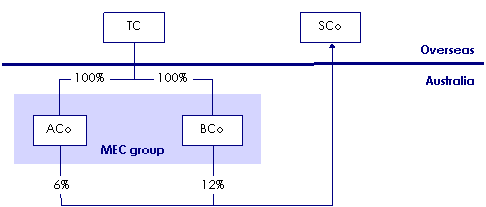Consolidation Reference Manual
You can still refer to the Consolidation reference manual for consolidation information that has not been impacted by changes in the legislation.
C6 International
C6-2 Worked example
C6-2-310 Transfer of foreign dividend account balance
Description
This example shows the transfer of a joining company's foreign dividend account (FDA) balance to the head company of a consolidated group. It also shows how the head company uses the FDA surplus to pay non-resident shareholders unfranked dividends exempt from dividend withholding tax.
Commentary
The FDA balance of a company that becomes a subsidiary member of a consolidated group is transferred to the head company of the group. The FDA surplus in the head company's account enables that company to pay unfranked dividends to the non-resident shareholders of the group, free from dividend withholding tax.
Where a company leaves a consolidated group, the leaving company is not entitled to take any FDA balances with it on exit. If the leaving company operates an FDA after the leaving time, the rules in Subdivision B of Division 11A of the ITAA 1936 apply.
Example
Facts
ACo and BCo are wholly-owned subsidiaries of TC - the top company. ACo and BCo are both eligible tier-1 companies. On 1 July 2004 they form a MEC group, jointly nominating ACo to be the provisional head company of the MEC group. ACo is the provisional head company at the end of the MEC group's income year and so is taken to be the head company of the group for the whole of its income year.
At the formation time, ACo holds a 6% foreign investment in SCo but does not operate an FDA as the dividends paid by SCo are not non-portfolio dividends. BCo holds a 12% foreign investment in SCo and has an FDA surplus of $5,000. No further foreign investments are made by ACo or BCo.
Figure 1: Foreign investments of MEC group

On 1 September 2004, SCo pays a dividend of $4,400 to ACo and $6,600 to BCo. ACo incurs an expense of $2,000 on 1 October 2004 that relates to the dividends paid by SCo. No further credit or debit entries are made to ACo's FDA.
On 31 December, ACo and BCo both pay a dividend to TC. ACo pays a dividend of $12,000 and BCo pays one of $10,000. The FDA declaration percentage specified by ACo is 75%, while BCo specifies 60%.
Calculation
The FDA surplus of $5,000 is transferred to ACo by debiting BCo's FDA for $5,000 at the balance time (that is, the time just before the joining time) and crediting ACo's FDA for $5,000 at the joining time. At the joining time ACo is also able to aggregate the total foreign investment holding and operate a single FDA based on the group's 18% foreign investment.
The dividends received by ACo give rise to an FDA credit of $11,000 in ACo's account on 1 September 2004. The $2,000 expense incurred by ACo in relation to the dividends received gives rise to an FDA debit in ACo's account on 1 October 2004. The balance in ACo's FDA is $14,000.
When ACo pays an unfranked dividend to TC on 31 December, the FDA surplus at the beginning of that day is $14,000. To pay TC unfranked dividends free from dividend withholding tax, ACo needs to ensure the FDA declarations do not exceed the FDA surplus available at the beginning of the day.
The dividend payment of $12,000 with an FDA declaration percentage of 75% would have an FDA declaration amount of $9,000. The dividend payment of $10,000 with an FDA declaration of 60% would have an FDA declaration amount of $6,000. The sum of the declaration amounts is $15,000, which exceeds ACo's FDA surplus of $14,000 at the beginning of the day.
ACo needs to proportionally reduce the FDA declaration percentage for each FDA declaration made. The proportional reduction is achieved by applying the following formula ( → subsection 717-525(3)):
FDA declaration percentage actually specified in the declaration * (That FDA surplus / That sum)
The FDA declaration percentage that ACo is taken to have declared, and the corresponding FDA declaration amounts, are shown in table 1.
| Table 1: Proportional reduction of declaration percentages and amounts | |||||||||
|---|---|---|---|---|---|---|---|---|---|
| Spec. % | x | FDA surplus / Sum | = | Reduced % | x | Dividend amount | = | Declaration amount | |
| Dividend paid by ACo | 75% | x |
$14,000 $15,000 |
= | 70% | x | $12,000 | = | $8,400 |
| Dividend paid by BCo | 60% | x |
$14,000 $15,000 |
= | 56% | x | $10,000 | = | $5,600 |
| Total | $14,000 | ||||||||
The FDA declarations made give rise to an FDA debit of $14,000 in ACo's account on 31 December 2004.
References
Income Tax Assessment Act 1997, Division 717 - as amended by New Business Tax System (Consolidation and Other Measures) Act 2003 (No. 16 of 2003)
Current at 28 May 2003
